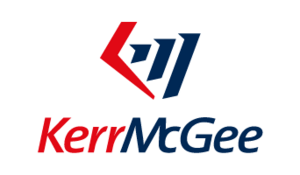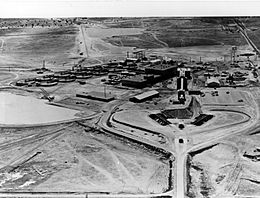Kerr-McGee facts for kids

Kerr-McGee Corporation logo
|
|
|
Formerly
|
Anderson & Kerr Drilling; Kerlyn Oil Co.; Kerr-McGee Oil Industries Inc. |
|---|---|
| Industry | Energy |
| Fate | Acquired by Anadarko Petroleum |
| Founded | 1929 in Oklahoma, United States |
| Founder | Robert S. Kerr |
| Defunct | 2006 |
| Headquarters | , |

The Kerr-McGee Corporation, founded in 1929, was an American energy company involved in oil exploration, production of crude oil, natural gas, perchlorate and uranium mining and milling in various countries. On June 23, 2006, Anadarko Petroleum acquired Kerr-McGee in an all-cash transaction totaling $16.5 billion plus $2.6 billion in debt and all operations moved from their base in Oklahoma, United States.
Contents
History
The company later known as Kerr-McGee was founded in 1929 as Anderson & Kerr Drilling Company by Oklahoma businessman-politician Robert S. Kerr (1896-1963) and oil driller James L. Anderson. When Dean A. McGee (1904-1989), a former chief geologist for Phillips Petroleum, joined the firm in 1946, it changed its name to Kerr-McGee Oil Industries, Incorporated. The company initially focused mostly on off-shore oil exploration and production, being one of the first companies to use drillships in the Gulf of Mexico, and later one of the first companies to use a Spar type platform in the area.
With the acquisition of the Oryx Energy Company of Dallas, Texas in 1999, Kerr-McGee gained more onshore assets, as well as significant assets in several foreign areas, most notably Algeria and western Kazakhstan. Later acquisitions of HS Resources and Westport Resources Corp. established the base of operations in Denver, Colorado and added large resource areas throughout the Rocky Mountains.
Until 2005, Kerr-McGee had two major divisions: chemical and oil-related. On November 21, 2005, the chemical division of the company, based in Oklahoma City, was sold off by IPO as Tronox, thereby making Oklahoma City home to the administrative side of Kerr-McGee, while all exploration and production management was located in Denver and Houston.
On June 23, 2006, Anadarko Petroleum, based in The Woodlands, Texas, purchased Kerr-McGee in an all-cash transaction totaling $16.5 billion plus the assumption of $2.6 billion in debt. Kerr-McGee shareholders approved the offer on August 10, 2006, and Kerr-McGee ceased to exist as an independent entity. All operations with the exception of Tronox which was spun off as a separate company in 2005 moved out of Oklahoma. Within a few years, the top positions at Anadarko had been filled by Kerr-McGee employees and many long-time Anadarko employees had left or been removed from the company, effecting a de facto name change for Kerr-McGee.

Kerr-McGee v. Navajo Tribe, 471 U.S. 195 (1985), was a case in which the Supreme Court of the United States held that an Indian tribe is not required to obtain the approval of the Secretary of the Interior in order to impose taxes on non-tribal persons or entities doing business on a reservation.
In 1978, the Navajo Tribal Council passed two taxing ordinances. The first was a tax of 3% on leaseholds (such as mineral rights) and the second was a 5% tax on business activity.
Kerr-McGee held substantial mineral rights on the Navajo Nation and filed a lawsuit in the federal district court seeking an injunction to prohibit the tribe from collecting the tax. Kerr-McGee argued that any tax of non-Indians by a tribe required approval by the Secretary of the Interior and the district court agreed, granting the injunction. The tribe appealed to the Ninth Circuit Court of Appeals. The Ninth Circuit overruled the district court, finding no federal statute or regulation required such approval. Kerr-McGee then appealed to the Supreme Court, which granted certiorari and agreed to hear the case. The court decided unanimously that the Navajo Nation had the right to tax Kerr-McGee because tribal authority to tax had already been recognized, and because no federal law prohibited exercising tribal sovereignty in enacting a tax.
Locations
United States
Main oil and gas operations in the US were the Mid-Continent, Rocky Mountains, onshore Louisiana, and offshore in the Gulf of Mexico. Main offices were located in downtown Denver and the Greenspoint area of Houston.
Corporate headquarters were located in Downtown Oklahoma City. In the 1970s the company had a forest products division, and mineral mining in New Mexico, Arizona, and Idaho, and coal mining in Wyoming and Illinois. Most of the U.S operations were on land owned by the U.S. government (i.e. Bureau of Land Management, National Forest) and the Navajo Indian tribe. Kerr-McGee owned a potash operation in California from 1974 to 1990.
Mainland China
Kerr-McGee had exploration, development, and production projects in Bohai Bay, China, near Beijing. Additional exploration was planned for the South China Sea. These operations were run primarily from an office in Beijing.
Other locations
Kerr-McGee and its subsidiaries formerly operated in western Kazakhstan, western Australia, Brazil, Trinidad, Benin, the United Kingdom and several other more minor locations around the world at various times.
Environmental record
Kerr-McGee is at least partially responsible for large scale perchlorate water contamination first discovered in the Lower Colorado River in 1997; It stemmed from land used by a facility in Henderson, Nevada which was owned and operated by Kerr-McGee Chemical LLC (as of 2011 Tronox LLC), where perchlorate was produced from 1945 until 1998.
In May 2007, Kerr-McGee Corp spent $18 million on pollution controls in the first comprehensive settlement under the Clean Air Act that reduced harmful emission and conserved natural gas at production facilities across Utah and Colorado. The settlement addressed violations discovered at several of Kerr-McGee's natural gas compressor stations located on the Uintah and Ouray Indian Reservation near Vernal, Utah, and in the Denver Julesburg Basin near Weld County, Colorado. In addition to implementing pollution controls, the agreement required Kerr-McGee to pay a $200,000 penalty, and spend $250,000 on environmental projects to benefit the areas in which violations occurred. In July 2005, the United States Environmental Protection Agency (EPA) settled with Kerr McGee Chemical in Henderson, Nevada that required the company to pay $55,392 penalty to resolve air permitting violations at its facility that began in 1993. The EPA cited Kerr-McGee for failing to install carbon monoxide emissions controls required under the Clean Air Act when it installed a new open hearth furnace in 1993. The company spent $4.8 million to install proper pollution controls at the facility reducing total carbon monoxide emission by 115 tons per year, an 80% reduction from previous levels.
Nuclear production
Kerr-McGee was involved in several nuclear endeavors.
In 1952 Kerr-McGee bought the Navajo Uranium Mining Company, including an interest in a number of mines. It also bought an ore buying station at Shiprock, New Mexico. In 1953 it built a processing plant (called the Shiprock Mill) near the buying station. In 1963 the mines and mill were sold to the Vanadium Corporation of America.
Later a partnership with other companies was formed called the Kermac Nuclear Fuels Corporation. In 1957-58 this partnership built a uranium mill near Grants, New Mexico and Ambrosia Lake. In 1983 the mill was taken over by a new Kerr-McGee subsidiary called the Quivira Mining Corporation. Quivira was sold to Rio Algom in 1989.
Kerr-McGee purchased the Lakeview Mining Company of Lake County, Oregon in 1961. The plant was shut down in late 1960 or 1961 and sold to Atlantic Richfield in 1968.
From about 1962-1966 Kerr-McGee processed uranium at its oil refinery site in Cushing, Oklahoma. It received licenses in 1962 for processing uranium and thorium, and in 1963 for enriched uranium. In 1966 it stopped production. An attempt was made to move all regulated nuclear material to the company's new Cimarron facility at Crescent, OK. Cleanups were attempted in 1966, 1972, 1979–82, and the 1990s
In about 1965 Kerr-McGee started producing uranium fuel at its Cimarron Fuel Fabrication Site. This was located near the Cimarron River and Crescent, Oklahoma. From 1973 to 1975 it would also produce mixed Plutonium-Uranium Oxide (MOX) 'driver fuel pins' for use in the Fast Flux Test Facility at the Hanford Site in Washington State. The plant shut down in 1976.
In 1967 Kerr-McGee bought the American Potash and Chemical Company, which owned the Rare Earths Facility in West Chicago, Illinois. This facility produced thorium, radium, and uranium by acid leaching of monazite sands and other ores. It stopped work in 1973.
In 1968 the company started construction on what would become the Sequoyah Fuels Corporation plant in Gore, Oklahoma. In 1970 the plant started turning yellowcake uranium into uranium hexafluoride. In 1987 it began producing depleted uranium tetrafluoride using depleted uranium hexafluoride as input. In 1988 SFC was sold to General Atomics. In late November 1993 production ceased after a stuck valve in the processing plant stuck open and caused an uncontrolled reaction. The uncontrolled reaction resulted in a large visible cloud leaving the plant. Production ceased immediately and the plant operations were suspended to never resume.
Nuclear corporations, subsidiaries, and spinoffs
In 1956 Kerr-McGee formed the Kermac Nuclear Fuels Corporation in partnership with Anderson Development Corp, and Pacific Uranium Mines Co. It was active in New Mexico.
Some time in the 1970s, the Kerr-McGee Nuclear Corporation was formed. In 1983 it split into the Quivira Mining Corporation and Sequoyah Fuels Corporation. Quivira got the Ambrosia Lake, NM mine, while Sequoyah Fuels took over the Sequoyah plant in Gore, OK, as well as the Cimarron plant in Crescent, OK. Sequoyah was sold to General Atomics in 1988. and Quivira was sold to Rio Algom in 1989.
The Cimarron Corporation was a subdivision that took control of the Cimarron plant in 1988. When Tronox was spun off in 2006, it would get ownership of Cimarron Corporation and responsibility for the plant as well.
Kerr-McGee bought the American Potash and Chemical Company in 1967, including its Rare Earths Facility that processed uranium and thorium. AMPOT became Kerr-McGee Chemical Company around 1970 or 1974. In 2005 this became Tronox. Tronox became independent in 2006, a few months before Kerr-McGee was sold to Anadarko Petroleum. Tronox later went bankrupt, blaming in part the environmental liabilities inherited from KMC. In 2009 purchasers of Tronox filed a class action lawsuit against Anadarko for having allegedly misled investors.
Licenses
In the US, nuclear companies must get licenses from the Nuclear Regulatory Commission. Kerr-McGee licenses follow:
- SNM-928 - Cimarron - uranium fuel fabrication
- SNM-1174 - Cimarron - mixed oxide fuel (MOX) fabrication - ?-1993
- STA-583 - Rare Earths Facility
- SMB-664 - Cushing refinery - uranium and thorium. 1962-1966
- SNM-695 - Cushing refinery - enriched uranium. 1963-1966
- SNM-1999 - Cushing refinery - cleanup. 1993-2006
- SUB-1010 - Sequoyah
- SUA-1473 - Ambrosia Lake source materials license (currently managed by BHP)



